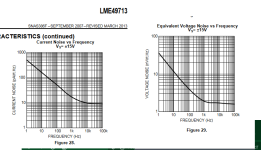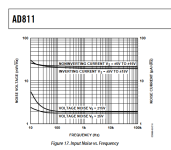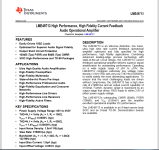On paper, they seem same. As I mentioned above, you should try metal-can version. Just give it a try.After a quick look at the data sheet of the LME49720, the specs are indistinguishable from an LM4562. I'm talking about exact same numbers! It's uncanny. I wonder if they are the same part? In any case, I've been a big fan of the sound of the LM4562 for a number of years so I will have to try that in my I/V stage. I never thought of doing that. Right now my DAC in progress will use an AD811. Thanks for the tip.
+1 for the lme49713 metal can, yupI know it is ad811 big brother.
I wanted to wait a GB at Rocester on another thread to ask people to buy some. Rocester is very expensive from Europe cause taxes everywhere.
This LME 49713 is said to be a good buffer for cans too.
This time Grunf sends me a skud
Consider also the AD8597 as a buffer (a very good cheaper alternative to AD797).
😉
I wanted to wait a GB at Rocester on another thread to ask people to buy some. Rocester is very expensive from Europe cause taxes everywhere.
This LME 49713 is said to be a good buffer for cans too.
This time Grunf sends me a skud
Consider also the AD8597 as a buffer (a very good cheaper alternative to AD797).
😉
Last edited:
So where can you get a metal can LME49720? I have found none.On paper, they seem same. As I mentioned above, you should try metal-can version. Just give it a try.
Hi,
try at Rocester as you have the luck to live in US, then try to add o tthe list somee LME49713HA (metal can as well), if you have the kindness to make a grup buy I ill take 4 713HA units. And I am sure some will jump in the train as well)
try at Rocester as you have the luck to live in US, then try to add o tthe list somee LME49713HA (metal can as well), if you have the kindness to make a grup buy I ill take 4 713HA units. And I am sure some will jump in the train as well)
The LME49720 is not avaiable in a metal can from Rochester but the the LME49713HA is available. The downside is that the minimum order at Rochester is 250 USD. I have an account and I will get some if enough people will go in on a group buy. Who wants in? Should I start a group buy in swap meet?
Guys, have you heard about popcorn noise that can appear with LME49720 or LM4562? I have never used them, so I have no experience with that problem , but there were a lot of complaints against TI because of it.
https://e2e.ti.com/support/audio-group/audio/f/audio-forum/725471/lme49720-popcorn-noise
https://e2e.ti.com/support/audio-gr...um/415907/lm4562-lme49720-low-frequency-noise
https://e2e.ti.com/support/audio-gr...20-excess-popcorn-noise-issue/3385884#3385884
As for the LME49713, it was not considered for testing because it is obsolete (although it can be obtained in Rochester) and because of the higher input impedance compared to the AD811.
Otherwise I have no doubt that both op amps sound good.
https://e2e.ti.com/support/audio-group/audio/f/audio-forum/725471/lme49720-popcorn-noise
https://e2e.ti.com/support/audio-gr...um/415907/lm4562-lme49720-low-frequency-noise
https://e2e.ti.com/support/audio-gr...20-excess-popcorn-noise-issue/3385884#3385884
As for the LME49713, it was not considered for testing because it is obsolete (although it can be obtained in Rochester) and because of the higher input impedance compared to the AD811.
Otherwise I have no doubt that both op amps sound good.
The LME49720 is not avaiable in a metal can from Rochester but the the LME49713HA is available. The downside is that the minimum order at Rochester is 250 USD. I have an account and I will get some if enough people will go in on a group buy. Who wants in? Should I start a group buy in swap meet?
If so, counts me in for 4 units. Boberly loved it. and also it makes an excellent buffer for cans or low Z input pre.
58 Z VS 14 Z ... we are low enough, And you have better specs on CMR and PSRR, better input noise and a very good Intermodulation distorsion, as well as that metal can good for thermal cooling as a CFB and shielding !
+1 for the bad emc/emi behavior of the lm4562 as said already everywhere.
Last edited:
@gaetano_au is selling them.So where can you get a metal can LME49720? I have found none.
https://www.diyaudio.com/community/threads/lme49710ha-and-lme49720ha-to-99.331739/post-7532883
But don't disregard OPA192/2192 as buffer/LPF after I/V. I tried other opamps after LME, they don't have same effect. My solution is a combo, not only I/V.
The main difference between them is that the LME49713 is made for audio AD811 for video signals. That's why it's no wonder that the LME will have better characteristics in the audio range, but regardless of that, it still has a lot more noise than the AD811 if you read the DSs carefully. In the case of DACs with low current output, this could also have an impact. According to my measurements, the AD811 has much lower noise than the AD4625 at the same position in the I/V conversion with all the same passive components, even with a 1k RN60 at the inverting input.58 Z VS 14 Z ... we are low enough, And you have better specs on CMR and PSRR, better input noise and a very good Intermodulation distorsion, as well as that metal can good for thermal cooling as a CFB and shielding !
If you read 'smedegaard 4217 aes pp' you know that the input impedance is the most important in I/V conversion, so the difference of almost 5 times higher input impedance is not insignificant.
Attachments
I wonder about the D1 with the IRF510 Mosfet , some have indeed chose to only focus on low input impedance vs the rest. I still think 58 Z is low vs a traditional VFB OPA input.
Some told me they have listened more transparent I/V, but I have not tried the D1 (zenmod has made a gerber somewhere for the tda1541A thread starter. AS for the noise of the LME49713HA noise characteristic, I think a benchmark at listening is mandatory. I trust some guys like Bob Pease that loved that caned one, or was it Boberbely ? I can't remember. Anyway the LME49713HE is hard to find as a NLA part...
Some told me they have listened more transparent I/V, but I have not tried the D1 (zenmod has made a gerber somewhere for the tda1541A thread starter. AS for the noise of the LME49713HA noise characteristic, I think a benchmark at listening is mandatory. I trust some guys like Bob Pease that loved that caned one, or was it Boberbely ? I can't remember. Anyway the LME49713HE is hard to find as a NLA part...
The 811 noise numbers look much better than the 49713. Please tell me more about the input z. I am not clear on which part is said to be better and why. Thanks!
@diyiggy D1 is a balanced I/V, it needs two DAC chips (and two IRF510) per channel for optimal operation.
@audiosteve The input z of a CFB amp into pin2 (-ve input) is that of a common-base stage BJT. So its typically in the region of 10's of ohms (depends on bias) and doesn't depend on loop feedback for this.
@grunf The notion that LME49713 is 'made for audio' is extreme irony, given the high noise corners in both voltage and current noise. Just from looking at those two plots I would have guessed 'made for RF' if I hadn't any other information. Whereas AD811 while being 'made for RF' is rather good in noise corner terms for audio.
@audiosteve The input z of a CFB amp into pin2 (-ve input) is that of a common-base stage BJT. So its typically in the region of 10's of ohms (depends on bias) and doesn't depend on loop feedback for this.
@grunf The notion that LME49713 is 'made for audio' is extreme irony, given the high noise corners in both voltage and current noise. Just from looking at those two plots I would have guessed 'made for RF' if I hadn't any other information. Whereas AD811 while being 'made for RF' is rather good in noise corner terms for audio.
Last edited:
Thanks for this info!!@grunf The notion that LME49713 is 'made for audio' is extreme irony, given the high noise corners in both voltage and current noise. Just from looking at those two plots I would have guessed 'made for RF' if I hadn't any other information. Whereas AD811 while being 'made for RF' is rather good in noise corner terms for audio.
I 'de add than if the guys of N.S.C said tje LME49713HA was the best they ever did for audio, they took as the base if their work the AD811. Those were made as video line drivers not for transimpedance task which made the paper if WJ something original while at the end of the paper is shown an illustration not as I/V.
Bob Pease and not only loved the LME (no dac stuffs) and was able I read here, to say in blind tests which was the canned one he always chose.
As i/v it is safe to cope to the ad811 as WJ designed the circuit for that purpose. For the low price of it I would try both for the curiosity if one is an enthusiast with multple I/V already. I certainly cut a fur in four as an hobyst.
Thanks Abeaxalito for the feedbacks...wonder why a guy like Bob Pease liked it so much.
too bad the D1 can not be adapted for SE for one dac chip... while a dozen of pcm58 with it migth have charms 😁
Bob Pease and not only loved the LME (no dac stuffs) and was able I read here, to say in blind tests which was the canned one he always chose.
As i/v it is safe to cope to the ad811 as WJ designed the circuit for that purpose. For the low price of it I would try both for the curiosity if one is an enthusiast with multple I/V already. I certainly cut a fur in four as an hobyst.
Thanks Abeaxalito for the feedbacks...wonder why a guy like Bob Pease liked it so much.
too bad the D1 can not be adapted for SE for one dac chip... while a dozen of pcm58 with it migth have charms 😁
Well, that's what it says in DS, it's not extreme irony it's the truth 🙂 .@grunf The notion that LME49713 is 'made for audio' is extreme irony, given the high noise corners in both voltage and current noise. Just from looking at those two plots I would have guessed 'made for RF' if I hadn't any other information. Whereas AD811 while being 'made for RF' is rather good in noise corner terms for audio.
Honestly, I took a closer look at the DS yesterday for the first time and I was also shocked when I saw the noise corners. TI probably went with the intention that the LME49713 works as a buffer, some kind of line stage with low gain or something similar where it will not work with high gain and small signals.
Attachments
... or they simply killed the 49713 and others after having buying National SemiCOnductor ? Because there were many OPA enough ? Or the sells not high enough ?
Off topic but it seems the best place to ask here;
According to experiments at the thread below, passive I/V approach has no penalty up to the 50ohms resistor. So, why we don't follow a gain stage after a low value resistor? This approach makes it open to other possibilities like usage of non-unity-gain-stable opamps: e.g: AD828 which has excellent dynamic characteristics.
https://www.diyaudio.com/community/threads/testing-the-pcm1794.221743/post-3205164
According to experiments at the thread below, passive I/V approach has no penalty up to the 50ohms resistor. So, why we don't follow a gain stage after a low value resistor? This approach makes it open to other possibilities like usage of non-unity-gain-stable opamps: e.g: AD828 which has excellent dynamic characteristics.
https://www.diyaudio.com/community/threads/testing-the-pcm1794.221743/post-3205164
If you're not worried about noise then I would agree, its a good approach. You can see the noise penalty in the measurements @woodturner-fran made with AD797 being used in this mode with a 27ohm I/V resistor.
https://www.diyaudio.com/community/...llection-of-iv-converters.415094/post-7735440. Noise looks about 10dB worse than other options.
https://www.diyaudio.com/community/...llection-of-iv-converters.415094/post-7735440. Noise looks about 10dB worse than other options.
Actually noise is one of the my least concerned parameters until it is below 90-100dB. Recordings have much worse noise levels and the excitement comes from linearity along with the good dynamics in my opinion.
Since the measurements at that thread done with a 1mA dac chip, noise performance probably will be much better with 8x current and 2x resistor value (7.8mA * 50R vs 1mA * 27R).
Since the measurements at that thread done with a 1mA dac chip, noise performance probably will be much better with 8x current and 2x resistor value (7.8mA * 50R vs 1mA * 27R).
- Home
- Source & Line
- Digital Line Level
- AD811 as I/V stage for current DACs (and test some other opamps including Burson Audio opamps as I/V)


